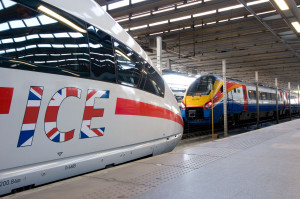DB drops plans to run Channel Tunnel passenger trains
DB’s decision to drop plans to run international trains to London is a bitter blow to those promoting European rail travel.
With HS1 and the Channel Tunnel it should be simple to connect London with European cities beyond Paris and Brussels. DB’s experience shows that it is not.
When the company presented its ICE train to crowds of admirers at St Pancras back in 2010, DB showed style and bravura. For Germany, went the unsaid message, anything is possible. That was to hide the company’s essentially cautious nature. International services may have been a way into the UK market but the subsequent purchase of Arriva provided that for far less risk.
DB is now behind Alliance Rail’s expansionist open access ambitions. If they, like the international trains, prove too difficult then I will not be surprised to see DB pull out, just as it did with Wrexham, Shropshire and Marylebone Railway.
To return to the Channel Tunnel, if DB was ambitious and cautious at the same time, others did not cover themselves in glory. I was never convinced the Intergovernmental Commission was sufficiently active to encourage new entrants (although it did grant DB a licence last summer). As a result, the Channel Tunnel retains its own rules that are stronger than Euro-standard rules that pertain in more challenging tunnels.
As I covered the news story over the years following 2010, something was never right. DB would complain that the trains it had ordered from Siemens were late; Siemens would point out that DB had not ordered trains compliant with Channel Tunnel rules and then DB would blame further delays on problems with an Italian signalling system switch. Meanwhile, Eurostar ordered the same trains (albeit in longer formations) with the same signalling, seemingly without problems.
Germany’s plan was always ambitious. UK rules for passport checks made proposed operations much harder and added time to journeys. Splitting trains at Brussels to serve Amsterdam and Frankfurt added timetable risk. It left the proposal on a knife edge between the sub-four journeys needed to compete with air and financial ruin.
Eurostar presses on with its plans and is set to launch London-Amsterdam trains in December 2016. That’s great but I’d welcome another operator through the Channel Tunnel to keep Eurostar on its toes.
Plan on ice. DB has dropped ambitious plans to link London with Frankfurt and Amsterdam. It launched the idea by bringing an ICE high-speed train to St Pancras on October 19 2010. PHILIP HAIGH.
A February night on SWT
After storm after storm, Christmas seems ages ago and yet rail staff in many parts of the country have been working above and beyond the call of duty since then.
Those most obviously affected are dressed in orange with hard hats. But we must not forget train crew whose rosters are changed, timetable planners who keep having to redo their work, and those managers who have to pull the whole show together. There will be plenty more jobs that I’ve not mentioned which have also been stretched.
February 14 was certainly a busy day with another storm tearing over Britain. I had to go to Salisbury and duly boarded SWT’s 1850 from Waterloo. All went well for the first hour, although I had noted an SWT ‘tweet’ part-way into my journey that warned against travel after 2000.
I was only 30 minutes away from ‘Sarum’ when my ‘159’ rolled to a halt at Overton station. There was a fallen tree ahead, we were quickly told. A little while later an Up train passed, which raised hopes. Unfortunately we then moved the same way, running ‘wrong road’ back to Basingstoke. We never made it, stopping somewhere – I couldn’t tell you where – with another tree on the line.
Meanwhile, the orange team had cleared the tree towards Andover so our driver changed ends and we headed west, to reach Whitchurch 169 minutes late.
More trees caused more delays and we were held outside Andover. Eventually we reached it, around four hours late, but only just! There were so many trains in Platform 2 that our six-car train had only its leading door at the platform.
Some passengers left for taxis, with one for Yeovil. No announcements revealed the plan for the rest of the journey and so it was another 45 minutes before Salisbury passengers were told to leave for a taxi. Seeing the row of ‘159s’ in the platform it became obvious we were never going to proceed beyond Andover but it would have been nice to have been told. Never mind, my planned 2020 arrival became after 0100.
So am I complaining? Not really. The railway and its staff have been through one of the toughest periods I can remember (worse at ground level than Hatfield’s aftermath I reckon). I salute them all for their efforts.
Reopening the ‘Withered Arm’
My old mate Andrew Roden made a sterling case in RAIL 742 for reopening the LSWR route through Okehampton to provide a diversion around Dawlish and its troubled sea wall.
However, both Dawlish and Okehampton rely on a single flood hotspot – Cowley Bridge Junction. Here, Network Rail erects water booms across the track whenever floods threaten so that it can protect signalling equipment. If the line here is blocked then Devon and Cornwall is cut-off, whether or not there’s a line through Okehampton or through Dawlish.
Perhaps a new cut-off between Rewe and Newton St Cyres station to avoid Cowley Bridge will help, as south-western stalwart Tony Berkeley suggests. With other improvements, this could cut 40 minutes from a journey to Cornwall, the peer comments.
